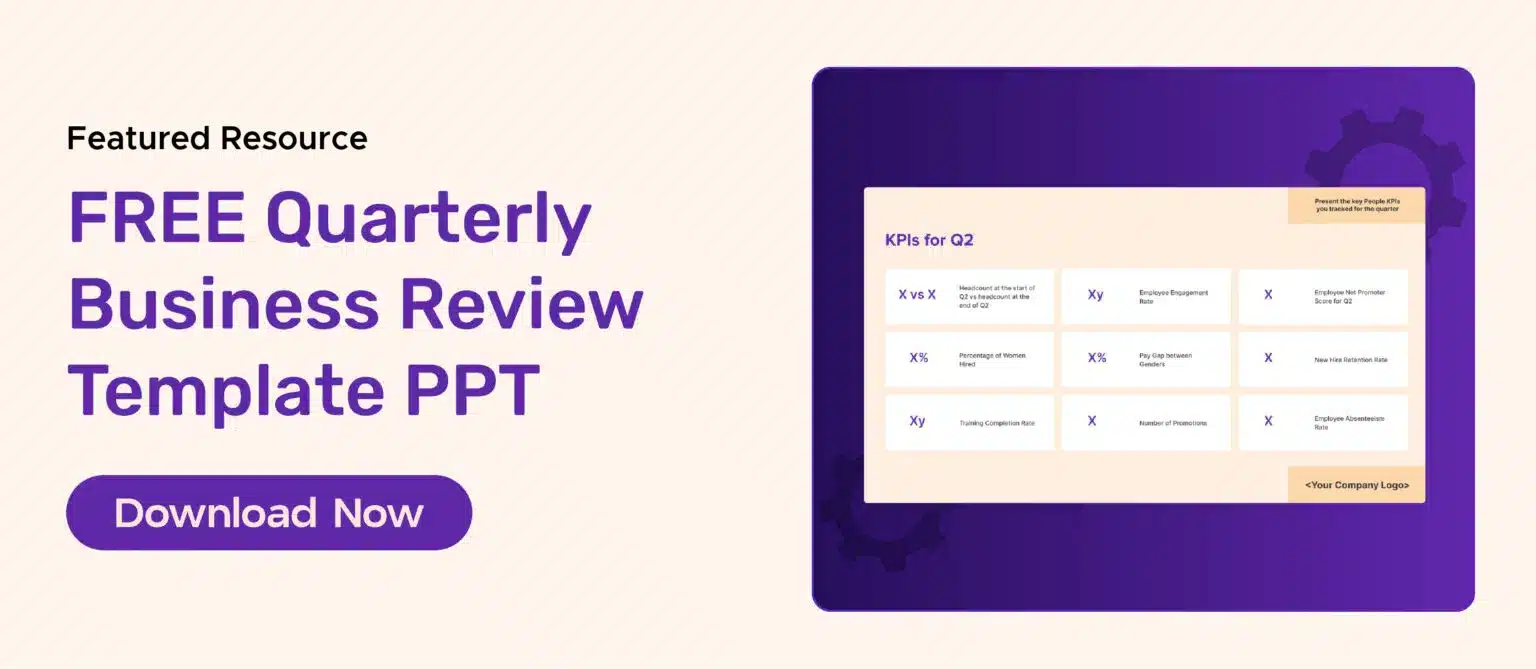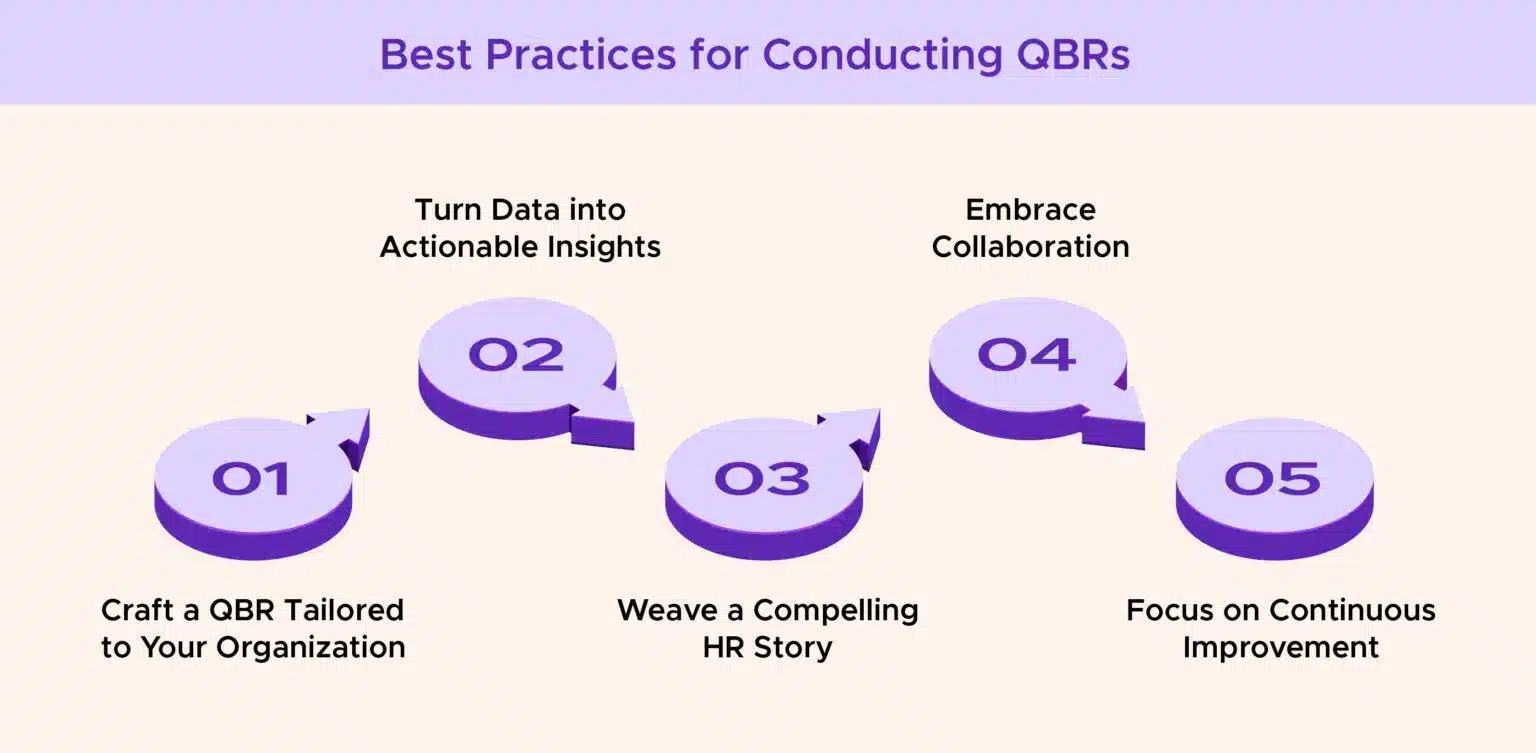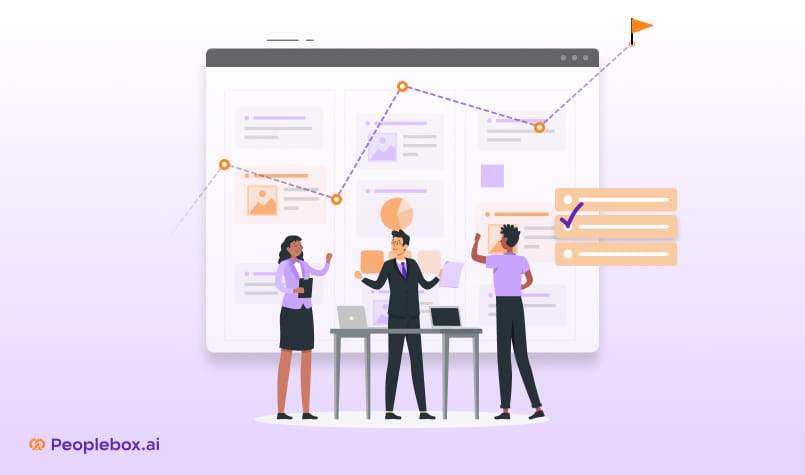You’re at a board meeting, and the CEO asks, “How exactly are HR initiatives impacting our bottom line?”
Silence.
We’ve all been there.
While HR plays a vital role in attracting, developing, and retaining top talent, its impact on the organization’s balance sheets can sometimes be a mystery to executives focused on immediate ROI.
This is where the Quarterly Business Review (QBR) becomes your secret weapon. A well-planned HR quarterly business review is an opportunity to showcase the strategic value HR brings to the table. This blog post will equip you with all the tools you need to conduct impactful HR QBRs. By the end of this guide, you’ll be ready to confidently answer that boardroom question and solidify HR’s position as a strategic partner in driving organizational growth.

What is Quarterly Business Review for HR, and Why is it Important?
Quarterly Business Reviews are structured meetings held every three months where a business or a specific department within a business reviews its performance, strategies, and goals. The primary purpose of QBRs is to ensure alignment between the company’s strategic objectives and its operational activities, evaluate progress, and identify areas for improvement.
Why are Quarterly Business Reviews Important?
Demonstrating HR’s Value
One primary reason for conducting an HR QBR is to showcase the impact of HR initiatives on overall business goals. By presenting data-driven insights and highlighting key achievements, HR teams can demonstrate their value and contribution to the organization’s success. This not only strengthens the perception of HR as a strategic function but also helps secure buy-in and support from senior leadership during future meetings for initiatives.
Data-Driven Decision Making
The QBR process allows HR teams to delve deep into relevant data and analyze trends across various metrics, such as employee engagement, diversity and inclusion, pay equity, and overall workforce demographics. By identifying areas of strength and opportunities for improvement, HR professionals can make informed decisions about their strategies and allocate resources more effectively. This data-driven approach ensures that HR initiatives are grounded in facts and aligned with the organization’s needs.
Alignment with Business Goals
A well-executed HR QBR helps bridge the gap between HR and the broader business objectives. By reviewing progress against previously set goals and aligning HR initiatives with the organization’s overall strategy, HR teams can ensure that their efforts are contributing to the company’s success. This alignment fosters a sense of unity and collaboration across different departments, as HR works hand-in-hand with other functions to drive the organization forward.
Improved Communication & Collaboration
The QBR process encourages open communication and transparency between HR and stakeholders across the organization. By regularly sharing insights, challenges, and successes, HR teams can build trust and strengthen relationships with their colleagues. This collaborative approach not only enhances the effectiveness of HR initiatives but also promotes a culture of continuous learning and improvement.
Now that we’ve established the significance of QBRs for HR, let’s quickly look at the key components of effective quarterly reviews.
Key Components of an Effective QBR
A well-structured QBR is the foundation of a successful HR review. Think of it as your chance to craft a compelling narrative that showcases the impact HR has on the organization. Here’s a breakdown of the crucial components that will help you tell your strategic HR story:
Executive Summary
Think of this as the elevator pitch for your HR initiatives. In a concise and engaging way, summarize your key findings and insights. Briefly highlight major achievements from the previous quarter, challenges encountered, and any ongoing strategic initiatives. Here’s an example:
“This quarter, HR initiatives focused on improving employee engagement through a new wellness program. We saw a 15% increase in employee participation in wellness activities, leading to a 10% reduction in absenteeism. However, challenges remain in attracting diverse talent. Moving forward, we’ll be implementing a targeted recruitment strategy to address this gap.”
OKRs and Goal Alignment
Did you hit the bullseye? Clearly outline the Objectives and Key Results (OKRs) established for HR at the beginning of the quarter. Here’s your chance to demonstrate how effectively your initiatives aligned with achieving those goals.
“One of our key objectives this quarter was to improve employee retention by 5%. Through a revamped onboarding program and mentorship initiatives, we achieved a 7% retention rate, exceeding our initial target.”
Peoplebox offers a comprehensive OKR management platform that helps you streamline your OKR process, enhance collaboration, and drive meaningful discussions around goal alignment and achievement.
Performance Metrics
Go beyond vanity metrics! Showcase key HR metrics that demonstrate progress and impact. Use visuals like charts and graphs to highlight month-on-month trends for relevant metrics, such as:
- Employee Engagement: Track employee sentiment through surveys, focus groups, or participation rates in company events.
- Diversity, Equity, Inclusion & Belonging (DEIB): Monitor progress towards DEIB goals by analyzing workforce demographics and representation in leadership positions.
- Pay Equity: Ensure fair compensation practices by analyzing pay gaps between genders and ethnicities.
- Overall Employee Demographics: Identify trends in workforce demographics like age, tenure, and skill sets to inform future talent acquisition strategies.
- Headcount Management: Track your efficiency in managing headcount by analyzing recruitment costs, time-to-fill positions, and turnover rates.
- New Hire Performance: Measure new hire productivity and engagement during their first few months to evaluate the effectiveness of onboarding programs.
Strategic Initiatives
Deep dive into the progress of ongoing HR initiatives and projects. Explain what you’ve accomplished, analyze their impact on achieving business goals, and identify any areas for improvement. For instance:
“We implemented a new skills development program in the current quarter to address a critical skill gap in our customer success team. Initial results from customer feedback show a 20% increase in customer satisfaction, indicating better customer relationships. Moving forward, we’ll be expanding the program to other departments.”
Challenges and Opportunities
No journey is perfect. Identify key challenges faced by the HR team during the quarter, such as high turnover rates in a specific department or difficulties attracting top talent in a competitive market. Don’t just present problems; use them as springboards for growth. Highlight potential opportunities for improvement and propose solutions to address these challenges.
“A major challenge this quarter was a spike in turnover within the marketing department. We’ve identified low morale as a contributing factor. To address this, we’ll be conducting exit interviews and employee surveys to gather more data. Based on the findings, we’ll be developing targeted initiatives to improve employee satisfaction and retention within the marketing team.”
Action Plans and Roadmap
This section focuses on setting goals for the upcoming quarter and outlining specific action plans to achieve these objectives. By defining clear goals and actionable steps, HR can drive progress and ensure alignment with the organization’s strategic direction.
Here’s an example:
Challenge: High turnover rate in the Sales team (10% in Q2)
Action Plan:
Goal: Reduce Sales department turnover rate to 5% by Q4.
- Action 1 (Owner: HR Manager): Conduct exit interviews with departing Sales employees to understand key reasons for leaving (Timeline: July).
- Action 2 (Owner: Sales Director & HR Business Partner): As a next step, implement a stay interview program to identify potential turnover risks and address employee concerns proactively (Timeline: August).
- Action 3 (Owner: HR Team): Review and potentially revise compensation and benefits packages for the Sales department to ensure competitiveness within the industry (Timeline: September).
- Action 4 (Owner: Sales Director & HR Training Specialist): Develop and launch a targeted training program focused on career development opportunities within the Sales department (Timeline: October).
FREE Quarterly Business Review Template PPT
Are you ready to take your HR Quarterly Business Reviews to the next level? Look no further than our comprehensive QBR template slide deck, designed to help you streamline your review process, communicate your impact effectively, and drive meaningful change within your organization.
Using our free QBR template is easy! Simply download the PPT file and customize it to fit your organization’s specific needs and preferences.

Best Practices for Conducting QBRs
Conducting an effective QBR for HR requires a strategic approach that combines data-driven insights, clear communication, and collaborative efforts. By following best practices and continuously refining the process, HR teams can ensure that their QBRs deliver meaningful results and drive organizational success. Let’s explore some key best practices for conducting impactful HR QBRs:

Customization: Tailor the QBR presentation template to your organization’s unique culture, goals, and challenges. Focus on metrics most relevant to your situation and prioritize areas needing the most attention. Adapt the presentation style to resonate with your audience.
Data is Your Superpower: Gather accurate, recent data from various sources and analyze it to uncover hidden stories. Identify trends, patterns, and connections to make informed decisions and develop data-driven strategies. Use charts and graphs to present complex information in a clear and captivating way.
Become a Master Storyteller: Craft a compelling narrative that showcases the impact of your HR initiatives. Highlight the human element and connect the dots between HR’s work and positive outcomes for employees and the organization. Use case studies, employee quotes, and engaging visuals to create a strong emotional connection.
Collaboration is Key: Break down silos by involving cross-functional teams in the QBR process. Gain valuable insights, identify areas of collaboration, and ensure HR initiatives align with broader organizational goals. This fosters a sense of shared accountability and promotes a big picture view of the organization’s performance.
Continuous Improvement: Your QBR PowerPoint template is a living document. Seek feedback from stakeholders, gather insights on the process, and identify areas for improvement. By continuously adapting and refining your approach, you can ensure your HR QBRs stay focused, impactful, and aligned with your organization’s evolving needs.
How to Prepare for QBRs?
So, you’ve got your customized template and a captivating narrative in mind. Here are some key actions to ensure your HR QBR is a smooth and successful experience:
- Collect key HR metrics such as engagement scores, turnover rates, hiring stats, and diversity data well in advance. Ensure accuracy and up-to-date information.
- Define the purpose of the QBR, aligning it with broader organizational goals. Decide if the focus is on reviewing past performance, setting future goals, or strategizing.
- Create an agenda with specific time slots for each topic, including an executive summary, key metrics review, strategic initiatives, challenges, and next quarter’s plans.
- Make sure to invite the right attendees, including executives, managers, and key stakeholders.
- Identify significant trends and insights from the data. Provide context to help stakeholders understand underlying factors and overall performance.
- Anticipate questions and prepare thoughtful responses. Have backup data ready to support your points.
- Record key points, decisions, and action items from the QBR. Distribute meeting minutes and follow up on action items to ensure accountability and prepare for the next QBR meeting.
What are the Different Ways to Run QBR meetings?
Here are the most common ways to conduct a good QBR meeting:
- In-person meetings: Bringing the HR team and stakeholders together in a physical space for face-to-face discussions and presentations.
- Virtual meetings: Conducting the QBR using video conferencing tools, allowing for remote participation and collaboration.
- Hybrid meetings: Combining in-person and virtual elements, enabling both on-site and remote attendees to participate actively.
- Asynchronous meetings: Sharing the QBR presentation and materials asynchronously, allowing stakeholders to review and provide feedback at their convenience.
Remember, the format and approach to conducting these QBR meetings can vary depending on the organization’s needs, team dynamics, and technological capabilities.
Conduct Effective QBRs with Peoplebox
Peoplebox is the most integrated OKR, performance management and employee engagement platform that empowers HR teams to streamline their quarterly business reviews and ensure alignment with strategic objectives. Here’s how:
Streamlined Process: Peoplebox simplifies the QBR process by automating the syncing of OKRs and Key Performance Indicators, reducing the need for manual updates and ensuring that all relevant data is easily accessible.
Enhanced Collaboration: The integration with Slack enables HR teams to conduct performance reviews and QBRs in a collaborative environment, fostering open communication and encouraging active participation.
Customizable Dashboards: Peoplebox offers fully customizable dashboards that can be tailored to specific organizational needs, ensuring that the QBR process is tailored to the organization’s unique requirements.
Real-Time Progress Tracking: Peoplebox’s real-time progress tracking feature ensures that all stakeholders are informed and aligned with the latest key developments, and that any roadblocks can be identified and addressed promptly.
Ready to rock your next quarterly business review meeting? Get in touch with us today!







